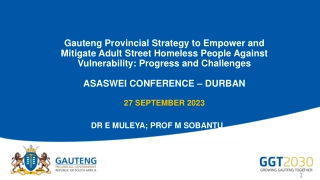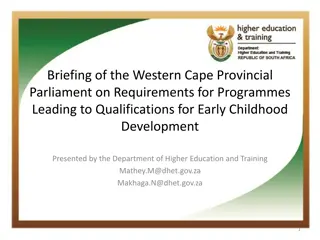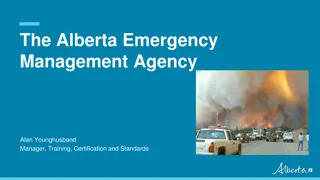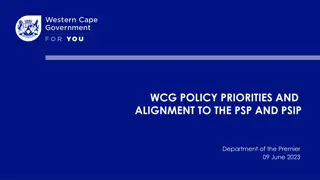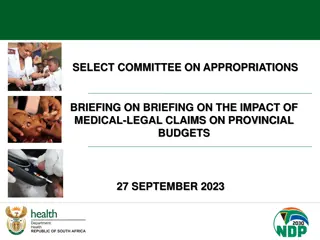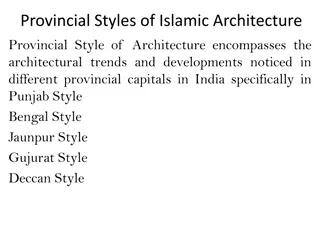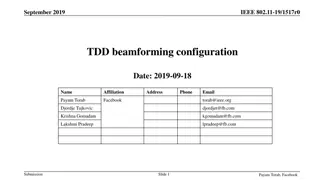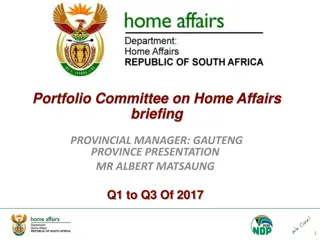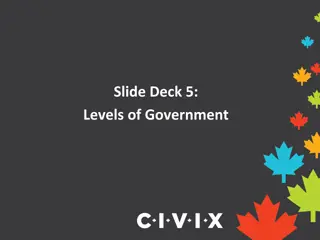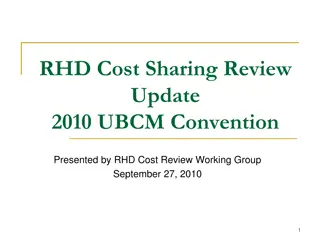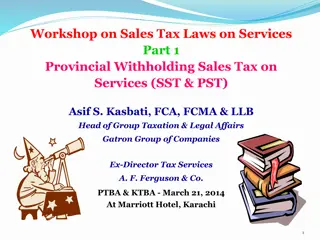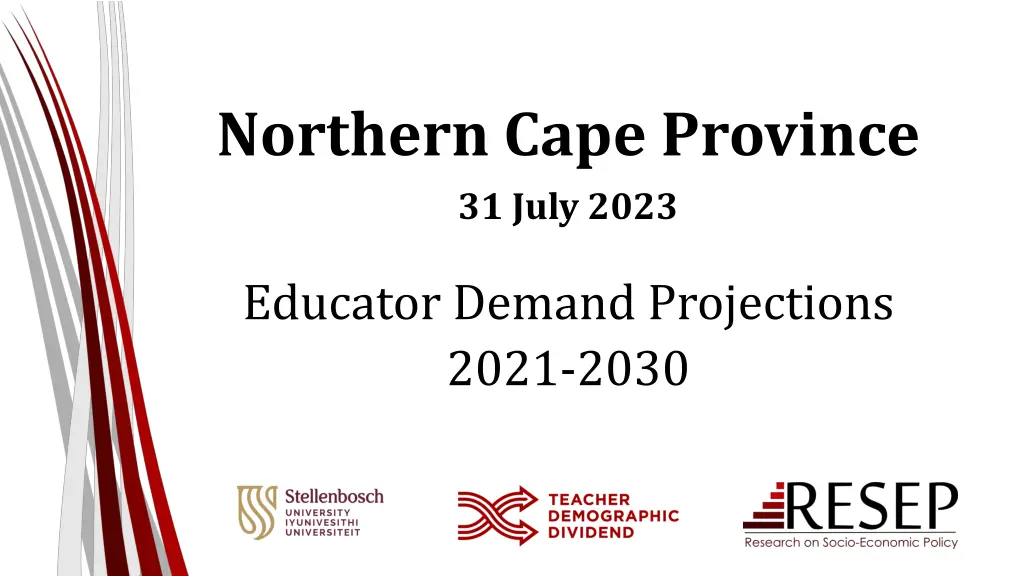
Educator Demand Projections in Northern Cape Province 31 July 2023
"Explore educator demand projections in the Northern Cape Province highlighting retirements, resignations, enrolment trends, and financial implications. Understand the age distributions, expected growth, and implications for appointments and class sizes."
Download Presentation

Please find below an Image/Link to download the presentation.
The content on the website is provided AS IS for your information and personal use only. It may not be sold, licensed, or shared on other websites without obtaining consent from the author. If you encounter any issues during the download, it is possible that the publisher has removed the file from their server.
You are allowed to download the files provided on this website for personal or commercial use, subject to the condition that they are used lawfully. All files are the property of their respective owners.
The content on the website is provided AS IS for your information and personal use only. It may not be sold, licensed, or shared on other websites without obtaining consent from the author.
E N D
Presentation Transcript
Northern Cape Province 31 July 2023 Educator Demand Projections 2021-2030
Introduction (1) The proportion of educators that are 50 years or older has steadily risen between 2012 to 2021 in South Africa. Nationally a wave of educator retirements is expected as older educators reach the standard retirement age of between 60 and 65. Implications: Many more appointments: The retirement wave will open up both teaching & school management & leadership positions & other office-based education specialists. Total compensation of educators: Since older teachers earn more, when retiring they are replaced with younger (less costly) teachers, although this overall benefit is offset by shift to 1.5% annual notch progression.
Introduction (2) As retirements increase, the required number of new appointments will need to increase to ensure that total educator numbers (at a minimum) stay at current levels and/or are sufficient to meet learner enrolment growth to prevent deterioration in learner-educator ratios. Planning will be required to ensure that provinces are ready for the sustained increase in appointments. If these positions are not filled, this could result in a further deterioration in the learner-educator ratio and lead to further increases in already large class sizes.
Objective In each province there are some differences in the age profile of teachers, differences in the expected growth of the school-going population and differences in expected teacher attrition (resignations & retirements). The year of the retirement wave peak will differ across provinces. Also some provinces need to accommodate much more growth in learners than others. In this presentation, we highlight the situation in the Northern Cape to inform province-specific planning.
Overview Age distributions Projected retirements & resignations Provincial population and enrolment trends Public and independent school growth Educator growth: Teachers and senior educators Expected financial implications to 2030 Movement of educators: Between and within provinces Gender imbalance in school management The implications for appointments and class sizes Discussion 10 1 2 3 4 5 6 7 8 9
Northern Cape educator demand summary Age distribution: The age distribution in the NC had a peak at around 49-51 years of age in 2021 Projected resignations and retirements: From 2022 onwards, the majority of educators projected to exit PERSAL were younger educators (ages 21 to 55); the number of senior educators (SMT positions and other specialists) that are retiring is expected to increase (69% were 50+ years old in 2021) Enrolment and population growth: Enrolment in NC ordinary schools increased by 10% from 2012-2021 (~ 27K learners), and the school-aged population is forecast to stay roughly constant to 2030. School rationalization may need to continue in response to this decrease. School and educator growth: Between 2012 and 2021, the public educator number has increased (+6%), and the number of public ordinary schools has decreased (-3%) SMT position changes: In NC, there has been a large decline in the number of Principals between 2012 and 2021 (-17%), conversely, the number of deputy principals has increased (+24%). Teacher (+9%) and HOD (+6%) numbers have also increased over this period. Projected educator cost trends: Educator unit cost to 2030 is projected to remain roughly constant (~+0,5%), mainly as change in age distribution leads to a decrease in senior educators unit costs (-6%) Educator movements: There is high movement out of the NC (~6%) as well as high movement to the NC (~6%) over 7 yrs. More than 8% of educators moved to a different school from 2018 to 2019. Appointments and LE Ratio: The learner-public educator ratio stayed similar (27.7 to 27.4) between 2012 and 2021. Little change to appointments numbers expected to 2030.
1 2 Age distributions and projected retirements and resignations
1 Educator age distribution (2021) The NC has a very similar age distribution to the whole of South Africa, with a higher proportion of educators are over 50 years old 6.0% % of educators at this age 5.0% 4.0% 3.0% 2.0% 1.0% 0.0% 21 26 31 36 41 46 51 56 61 NC SA Source: Anonymised PERSAL data from 2021, only educators (Rank 60 000 69 999) are considered. ECD practitioners, TVET lecturers and ABET teachers were removed.
1 Older teacher proportions for senior educator and primary schools educators Percentage of educators aged 50+ in 2021 Senior educators (HOD, Dep.- principals, Principals & Other) Primary school educators Province All educators EC 51% 71% 58% FS 43% 65% 49% GP 41% 65% 42% KN 39% 65% 44% LP 58% 81% 63% MP 50% 73% 55% NC 43% 69% 44% NW 47% 70% 52% WC 42% 73% 40% SA 49% 46% 69% Source: Anonymised PERSAL data from 2021, only educators (Rank 60 000 69 999) are considered. ECD practitioners, TVET lecturers and ABET teachers were removed. The 2021 rankclass file was expanded to include ranks found only in years prior to 2021, used to classify educators by rank. Primary school only includes all educators that are in a component that is classified as a Primary school.
1 Older teacher proportions for senior educator and primary schools educators Percentage of educators aged 50+ in 2021 Senior educators (HOD, Dep.- principals, Principals & Other) Primary school educators Province All educators EC 51% 71% 58% FS 43% 65% 49% GP 41% 65% zvc 42% Almost 70% of senior educators wereaged 50 years and older in 2021 in the NC KN 39% 65% 44% LP 58% 81% 63% MP 50% 73% 55% NC 43% 69% 44% NW 47% 70% zvc 52% WC 42% 73% 40% SA 49% 46% 69% Source: Anonymised PERSAL data from 2021, only educators (Rank 60 000 69 999) are considered. ECD practitioners, TVET lecturers and ABET teachers were removed. The 2021 rankclass file was expanded to include ranks found only in years prior to 2021, used to classify educators by rank. Primary school only includes all educators that are in a component that is classified as a Primary school.
1 Educator age distribution in 2021 & 2030 Assume constant 2021 educator numbers 5.0% ~Age 49-52 % of educators at this age 4.5% 4.0% 3.5% 3.0% 2.5% 2.0% 1.5% 1.0% 0.5% 0.0% 21 26 31 36 41 46 51 56 61 NC '302021 NC 2030 Source: Anonymised PERSAL data from 2021, only educators (Rank 60 000 69 999) are considered. ECD practitioners, TVET lecturers and ABET teachers were removed.
1 Educator age distribution in 2021 & 2030 Assume constant 2021 educator numbers A peak of younger educators (below age 32) is expected to develop by 2030 5.0% ~Age 49-52 % of educators at this age 4.5% 4.0% 3.5% 3.0% 2.5% 2.0% 1.5% 1.0% 0.5% 0.0% 21 26 31 36 41 46 51 56 61 NC '302021 NC 2030 Source: Anonymised PERSAL data from 2021, only educators (Rank 60 000 69 999) are considered. ECD practitioners, TVET lecturers and ABET teachers were removed.
2 Projected resignation & retirements (NC) Assume constant 2021 educator numbers Proportion of Educators The majority of educators that exit PERSAL in the NC are resignations (ages 21 to 55), not retirements Large spike in resignations and retirements in 2021 in the NC, perhaps due to COVID? And also, in 2015, due to pension reform rumours The number of young teachers (ages 21-30) resigning is projected to increase % of educators resigning or retiring Projected 16.0% 14.0% 12.0% 10.0% 8.0% 6.0% 4.0% 2.0% 0.0% Aged 21 to 30 Aged 31 to 55 Aged 56 to 65 Source: Anonymised PERSAL data from 2021, only educators (Rank 60 000 69 999) are considered. ECD practitioners, TVET lecturers and ABET teachers were removed. Estimates to 2035 derived from the National and provincial teacher supply and demand models assumption of no growth in educator numbers. Note: Retirements refer to all educators, aged 56 to 65, that leave PERSAL, whilst resignations refer to all educators aged 55 and below that leave PERSAL (as educators) for any reason.
2 Projected retirements (NC) Assume constant 2021 educator numbers Retirement headcount The number of retirements is projected to increase slightly, peaking in ~2029 & 2032 and then declining The number of retirements is projected to increase slightly from about 300 in 2022 to about 375 in 2030-32, an increase of about 75 retirements annually, a small change relative to total resignations and spike in 2020 and 2021 Projected 500 450 Number of retirements 400 350 300 250 200 150 100 50 0 Source: Anonymised PERSAL data from 2021, only educators (Rank 60 000 69 999) are considered. ECD practitioners, TVET lecturers and ABET teachers were removed. Estimates to 2035 derived from the National and provincial teacher supply and demand models assumption of no growth in educator numbers. Note: Retirements refer to all educators, aged 56 to 65, that leave PERSAL, whilst resignations refer to all educators aged 55 and below that leave PERSAL (as educators) for any reason.
2 Projected resignations (NC) Assume constant 2021 educator numbers Resignation headcount The number of resignations of 21 to 30 year-olds is projected to increase, almost doubling from 2022 to 2030, but numbers for 31 to 55 year olds is projected to remain relatively constant. There were two large spikes in resignations of educator aged 31-55. One in 2014 to 2015 (retirement fund rumours) and another from 2020 to 2021 (COVID?), such a spike is not observed elsewhere in SA Projected 1000 Number of resignations 800 600 400 200 0 Leavers 21 to 30 Leavers aged 31 to 55 Source: Anonymised PERSAL data from 2021, only educators (Rank 60 000 69 999) are considered. ECD practitioners, TVET lecturers and ABET teachers were removed. Estimates to 2035 derived from the National and provincial teacher supply and demand models assumption of no growth in educator numbers. Note: Retirements refer to all educators, aged 56 to 65, that leave PERSAL, whilst resignations refer to all educators aged 55 and below that leave PERSAL (as educators) for any reason.
2 Older leaver trend estimates to 2035 Assume constant 2021 educator numbers Cumulative proportion of estimated leavers aged 56-65 as a proportion of total educators in 2022 About 5,000 educators estimated to retire by 2035 in the EC (48% of total educators in 2021) 60% 50% 40% 30% 20% 10% 0% NC SA Source: Anonymised 2021 PERSAL data, only educators (Rank 60 000 69 999) are considered. ECD practitioners, TVET lecturers and ABET teachers were removed. Estimates to 2035 derived from the National and provincial models assumption of no growth in educator numbers.
2 Projected educators leaving Assume constant 2021 educator numbers Teachers (School based teachers) Senior educators (HODs, Deputy s, Principals & Other) % of teacher resigning & retiring 12% 12% % of senior educators 10% resigning & retiring 10% 8% 8% 6% 6% Careful succession planning is needed during this period as high numbers of HODs, deputies, and principals will be retiring A very high proportion of teachers are expected to resign and retire in the NC much of this is due to high proportions of younger teachers leaving 4% 4% 2% 2% 0% 0% NC SA Source: Anonymised 2021 PERSAL data, only educators (Rank 60 000 69 999) are considered. ECD practitioners, TVET lecturers and ABET teachers were removed. Estimates to 2035 derived from the National and provincial models assumption of no growth in educator numbers.
3 Provincial population and enrolment trends
3 Provincial enrolment trends (2012-2021) Ordinary school enrolment headcount 125% (Indexed with 2012 totals at 100%) GP WC High growth 120% 115% NW Moderate growth NC FS SA 110% MP 105% LP KN Stable 100% 95% Decline EC 90% 85% Source: Enrolment numbers taken from School Realities-EMIS (2012 2021) released by the DBE, using total numbers for ordinary public and independent schools.
3 Provincial enrolment trends (2012-2021) Ordinary school enrolment headcount 130% (Indexed with 2012 totals at 100%) Enrolment in Northern Cape ordinary schools increased by 10% from 2012 to 2021 125% 120% 115% NC SA 110% 105% 100% 95% 90% 85% 80% Source: Enrolment numbers taken from School Realities-EMIS (2012 2021) released by the DBE, using total numbers for ordinary public and independent schools.
3 Correlation between population and enrolment growth (2012- 2021) R2 = 0.9025 Strong positive correlation between population and enrolment growth between 2012 and 2021 45 Source: Thembisa age specific data V4.5 for school-aged population (Ages 7-18) estimates and enrolment taken from School Realities-EMIS (2012 2021) released by the DBE, for numbers on ordinary public and independent schools (Statistical Publications (education.gov.za))
3 Projected growth in school-aged population Population of children aged 7-18 in the Northern Cape, is expected to stay roughly constant, with a small increase of ~3,5K children (+1%) from 2021 to 2030 27% 30% 20% 15% 10% 7% 6% 6% 4% 1% -1% -4% 0% EC FS KN NC NW MP LP WC GP SA -10% -15% -20% Note: Period 2021 2030 is the same timeframe, nine years, as 2012 2021. Source: Thembisa age-specific estimates from the model V4.5 for children aged 7-18 by province
3 School aged-population estimates to 2030 Projected number of school-aged children (7-18 yrs) in Northern Cape Number of children Aged 7-18 2012 2021 Growth '12-21 Growth '21-30 Province 2030E 350 000 EC FS GP KN LP MP NC NW WC Total 1 657 202 592 445 1 962 793 2 485 822 1 395 864 977 749 254 075 742 943 1 068 009 11 136 902 12 541 746 13 337 172 1 598 475 676 489 2 498 533 2 690 378 1 507 386 1 100 594 277 560 893 530 1 298 801 1 361 637 650 820 3 180 884 2 657 716 1 612 125 1 165 728 281 208 930 323 1 496 731 -4% 14% 27% 8% 8% 13% 9% 20% 22% 13% -15% -4% 27% -1% 7% 6% 1% 4% 15% 6% 278K 281K 300 000 254K 250 000 200 000 150 000 100 000 50 000 0 Note: Period 2021 2030 is the same timeframe, nine years, as 2012 2021. Source: Thembisa age-specific estimates from the model V4.5 for children aged 7-18 by province
4 Public and independent school & educator growth
4 Educator, school and enrolment growth % growth from 2012 - 2021 Number of public ordinary schools Enrolment in public ordinary schools Enrolment in ordinary schools Number of educators Number of teachers Est. school-aged population Province EC FS GP KN LP MP NC NW WC SA -17% -13% 21% -5% -8% 3% 6% 2% 12% -1% -20% -13% 28% -3% -2% 7% 9% 4% 22% 2% -8% -27% 1% -3% -7% -8% -3% -9% 0% -6% -6% 9% 20% 1% 4% 7% 9% 12% 21% 7% -5% 10% 24% 1% 5% 8% 10% 13% 22% 8% -4% 14% 27% 8% 8% 13% 9% 20% 22% 13% Source: Educator numbers from anonymised PERSAL data from 2012 and 2021, only educators (Rank 60 000 69 999) are considered. Thembisa age specific data V4.5 for school-aged population (Ages 7-18) estimates and enrolment and school numbers taken from School Realities-EMIS (2012 2021) released by the DBE, for numbers on ordinary public and independent schools (Statistical Publications (education.gov.za))
4 Educator, school and enrolment growth % growth from 2012 - 2021 Number of public ordinary schools Enrolment in public ordinary schools Enrolment in ordinary schools Number of educators Number of teachers Est. school-aged population Province EC FS GP KN LP MP NC NW WC SA -17% -13% 21% -5% -8% 3% 6% 2% 12% -1% -20% -13% 28% -3% -2% 7% 9% 4% 22% 2% -8% -27% 1% -3% -7% -8% -3% -9% 0% -6% -6% 9% 20% 1% 4% 7% 9% 12% 21% 7% -5% 10% 24% 1% 5% 8% 10% 13% 22% 8% -4% 14% 27% 8% 8% 13% 9% 20% 22% 13% Enrolment and educator numbers increased somewhat in line with each other in the Northern Cape, however, the number of public ordinary schools declined slightly z z Source: Educator numbers from anonymised PERSAL data from 2012 and 2021, only educators (Rank 60 000 69 999) are considered. Thembisa age specific data V4.5 for school-aged population (Ages 7-18) estimates and enrolment and school numbers taken from School Realities-EMIS (2012 2021) released by the DBE, for numbers on ordinary public and independent schools (Statistical Publications (education.gov.za))
4 School growth from 2012 to 2021 School growth was driven by independent school growth (+37%) from 2012 to 2021. In contrast, the number of public schools in SA decreased (-6%) 100% 100% 80% 60% 65% 61% 54% 40% 37% 20% 26% 18% 19% 1% 16% 0% 0% -27% 0% -3% -3% -6% -7% -8% -8% -9% -20% -40% EC 4% FS 8% GP 30% KN 4% LP 5% MP 7% NC 7% NW 6% WC 17% SA 9% % independent schools (2021) Public Independent Source: School numbers taken from School Realities-EMIS (2012 2021) released by the DBE, for numbers on ordinary public and independent schools (Statistical Publications (education.gov.za))
4 School growth from 2012 to 2021 The number of independent schools in the NC doubled (+100%) vs. public schools (- 3%) off of a very low base of 20 schools. Independent school enrolment grew from about 9,6K to 24,5K children (+65%) 100% 100% 80% 60% 65% 61% 54% 40% 37% 20% 26% 18% 19% 1% 16% 0% 0% -27% 0% -3% -3% -6% -7% -8% -8% -9% -20% -40% EC 4% FS 8% GP 30% KN 4% LP 5% MP 7% NC 7% NW 6% WC 17% SA 9% % independent schools (2021) Public Independent Source: School numbers taken from School Realities-EMIS (2012 2021) released by the DBE, for numbers on ordinary public and independent schools (Statistical Publications (education.gov.za))
5 Educator growth by teachers and senior educators
5 Changes in teacher and SMT numbers Teacher HOD Deputy-Principal Principal % change % change % change % change Province 2012 2021 Diff 2012 2021 Diff 2012 2021 Diff 2012 2021 Diff EC 50 295 40 115 -10 180 -20% 5 870 6 196 326 6% 1 342 1 453 111 8% 5 294 4 755 - 539 -10% FS 20 148 17 561 -2 587 -13% 2 685 2 470 - 215 -8% 852 768 - 84 -10% 1 224 892 - 332 -27% GP 47 233 60 677 13 444 28% 8 708 9 209 501 6% 2 565 2 850 285 11% 2 162 1 959 - 203 -9% KN 73 050 71 000 -2 050 -3% 11 289 10 330 - 959 -8% 2 642 2 342 - 300 -11% 5 584 5 055 - 529 -9% LP 44 998 44 317 - 681 -2% 6 090 3 762 -2 328 -38% 1 562 778 - 784 -50% 3 510 3 316 - 194 -6% MP 26 127 27 857 1 730 7% 4 047 4 055 8 0% 1 108 1 114 6 1% 1 790 1 450 - 340 -19% NC 7 257 7 929 672 9% 1 034 1 094 60 6% 294 365 71 24% 587 488 - 99 -17% NW 21 305 22 261 956 4% 2 994 3 023 29 1% 902 1 041 139 15% 1 698 1 338 - 360 -21% WC 23 579 28 665 5 086 22% 4 065 3 700 - 365 -9% 1 334 1 297 - 37 -3% 1 531 1 339 - 192 -13% SA 313 992 320 382 6 390 2% 46 782 43 839 -2 943 -6% 12 601 12 008 - 593 -5% 23 380 20 592 -2 788 -12% Source: Anonymised PERSAL data from 2012 and 2021, only educators (Rank 60 000 69 999) are considered. ECD practitioners, TVET lecturers, and ABET teachers were removed. The 2021 rankclass file was expanded to include ranks found only in years prior to 2021.
5 Changes in teacher and SMT numbers Teacher HOD Deputy-Principal Principal % change % change % change % change Province 2012 2021 Diff 2012 2021 Diff 2012 2021 Diff 2012 2021 Diff EC 50 295 40 115 -10 180 -20% 5 870 6 196 Large decline in principal numbers between 2012 and 2021, relative to the decrease in public schools of -3%, and even larger increase in deputy principal numbers (+24%) (principal appointments potentially delayed by COVID) 326 6% 1 342 1 453 111 8% 5 294 4 755 - 539 -10% FS 20 148 17 561 -2 587 -13% 2 685 2 470 - 215 -8% 852 768 - 84 -10% 1 224 892 - 332 -27% GP 47 233 60 677 13 444 28% 8 708 9 209 501 6% 2 565 2 850 285 11% 2 162 1 959 - 203 -9% zvcd KN 73 050 71 000 -2 050 -3% 11 289 10 330 - 959 -8% 2 642 2 342 - 300 -11% 5 584 5 055 - 529 -9% LP 44 998 44 317 - 681 -2% 6 090 3 762 -2 328 -38% 1 562 778 - 784 -50% 3 510 3 316 - 194 -6% MP 26 127 27 857 1 730 7% 4 047 4 055 8 0% 1 108 1 114 6 1% 1 790 1 450 - 340 -19% NC 7 257 7 929 672 9% 1 034 1 094 60 6% 294 365 71 24% 587 488 - 99 -17% NW 21 305 22 261 956 4% 2 994 3 023 29 1% 902 1 041 139 15% 1 698 1 338 - 360 -21% zvcd WC 23 579 28 665 5 086 22% 4 065 3 700 - 365 -9% 1 334 1 297 - 37 -3% 1 531 1 339 - 192 -13% SA 313 992 320 382 6 390 2% 46 782 43 839 -2 943 -6% 12 601 12 008 - 593 -5% 23 380 20 592 -2 788 -12% Source: Anonymised PERSAL data from 2012 and 2021, only educators (Rank 60 000 69 999) are considered. ECD practitioners, TVET lecturers, and ABET teachers were removed. The 2021 rankclass file was expanded to include ranks found only in years prior to 2021.
5 Proportional split by educator rank All Educators 2012 Teacher 2012 HOD Dep.-Principal 2012 Principal 2012 Other 2021 2021 2012 2021 2021 2021 2012 2021 EC FS GP KN LP MP NC NW WC SA 100% 100% 100% 100% 100% 100% 100% 100% 100% 100% 100% 100% 100% 100% 100% 100% 100% 100% 100% 100% 78% 78% 74% 77% 78% 76% 75% 76% 74% 77% 75% 78% 79% 79% 84% 79% 77% 78% 80% 79% 9% 10% 14% 12% 11% 12% 11% 11% 13% 11% 12% 11% 12% 11% 7% 12% 11% 11% 10% 11% 2.1% 3.3% 4.0% 2.8% 2.7% 3.2% 3.0% 3.2% 4.2% 3.1% 2.7% 3.4% 3.7% 2.6% 1.5% 3.2% 3.6% 3.7% 3.6% 3.0% 8.2% 4.7% 3.4% 5.9% 6.1% 5.2% 6.1% 6.1% 4.8% 5.7% 8.8% 4.0% 2.6% 5.6% 6.3% 4.1% 4.8% 4.7% 3.7% 5.1% 2.5% 3.7% 4.4% 2.1% 2.1% 3.2% 5.1% 3.7% 4.1% 3.1% 2.4% 3.3% 2.7% 1.3% 1.5% 1.8% 3.9% 2.6% 2.1% 2.1% Source: Anonymised PERSAL data from 2012 and 2021. Only educators are considered. ECD practitioners, examination reviewers, ABET teachers and TVET lecturers were removed. Arrow shown for teachers and HODs if difference is at least 3 percentage points, for deputy principals if the difference is at least 0.6 percentage points and for principals a difference of at least 0.8 percentage points.
5 Proportional split by educator rank All Educators 2012 Teacher 2012 HOD Dep.-Principal 2012 Principal 2012 Other 2021 2021 2012 2021 2021 2021 2012 2021 EC FS GP KN LP MP NC NW WC SA 100% 100% 100% 100% 100% 100% 100% 100% 100% 100% 100% 100% 100% 100% 100% 100% 100% 100% 100% 100% 78% 78% 74% 77% 78% 76% 75% 76% 74% 77% 75% 78% 79% 79% 84% 79% 77% 78% 80% 79% 9% 10% 14% 12% 11% 12% 11% 11% 13% 11% 12% 11% 12% 11% 7% 12% 11% 11% 10% 11% 2.1% 3.3% 4.0% 2.8% 2.7% 3.2% 3.0% 3.2% 4.2% 3.1% 2.7% 3.4% 3.7% 2.6% 1.5% 3.2% 3.6% 3.7% 3.6% 3.0% 8.2% 4.7% 3.4% 5.9% 6.1% 5.2% 6.1% 6.1% 4.8% 5.7% 8.8% 4.0% 2.6% 5.6% 6.3% 4.1% 4.8% 4.7% 3.7% 5.1% 2.5% 3.7% 4.4% 2.1% 2.1% 3.2% 5.1% 3.7% 4.1% 3.1% 2.4% 3.3% 2.7% 1.3% 1.5% 1.8% 3.9% 2.6% 2.1% 2.1% There was a significant decline in the proportion of principals and the opposite for deputy principals, Teacher and HOD proportions are similar to the national averages zvc zvc zvc Source: Anonymised PERSAL data from 2012 and 2021. Only educators are considered. ECD practitioners, examination reviewers, ABET teachers and TVET lecturers were removed. Arrow shown for teachers and HODs if difference is at least 3 percentage points, for deputy principals if the difference is at least 0.6 percentage points and for principals a difference of at least 0.8 percentage points.
6 Expected financial implications to 2030
6 Unit cost drivers
6 Real and nominal costs Examples: In 2022 CPI was 7.2% If nominal wages increase by 7.2%, then real wages increase by 0% A real increase in wages takes place when wages increase above the rate of inflation If nominal wages increase by 9%, then real wages increase by 1.8% Changes to real wages are an indicator of purchasing power If nominal wages increase by 5%, then real wages decrease by 2.2%
6 Projected unit costs trends| All educators In constant 2021 rands 490,000 NC has a somewhat lower unit costs per educator than other provinces. Lower proportions of older educators and higher attrition levels among younger educators contribute to this lower unit cost. Average annual unit cost 480,000 (In 2021 Rands) 470,000 460,000 450,000 440,000 2022 2023 2024 2025 2026 2027 2028 2029 2030 NC SA Note: Scale not from zero Source: Own calculations, using the anonymised PERSAL data from 2021, only educators are considered. ECD practitioners and examination reviewers removed. Estimates to 2030 derived from the national and provincial TSD models. Assumption of no growth in educator numbers.
6 Indexed unit costs trends| All educators In constant 2021 rands 103% 102% (Index in 2022 = 100%) Educator unit cost GP: ~1% increase 101% 100% 99% WC: ~1.5% decrease 98% 97% Note: Scale not from zero EC FS GP KN LP MP NC NW WC SA Source: Own calculations, using the anonymised PERSAL data from 2021, only educators are considered. ECD practitioners and examination reviewers removed. Estimates to 2030 derived from the national and provincial TSD models. Assumption of no growth in educator numbers for FS, KN, LP, MP, NC, NW and SA. Assume 20% educator growth for GP, 10% for WC and a decline in 10% of educators in the EC. In LP assume that the proportion of senior educators grows from 16% in 2021 to 21% in 2030.
6 Indexed unit costs trends| All educators In constant 2021 rands 103% 102% (Index in 2022 = 100%) NC: Very slight (~+0,5%) increase in real cost from 2022 - 2030 Educator unit cost 101% 100% 99% 98% 97% Note: Scale not from zero NC SA Source: Own calculations, using the anonymised PERSAL data from 2021, only educators are considered. ECD practitioners and examination reviewers removed. Estimates to 2030 derived from the national and provincial TSD models. Assumption of no growth in educator numbers for FS, KN, LP, MP, NC, NW and SA. Assume 20% educator growth for GP, 10% for WC and a decline in 10% of educators in the EC. In LP assume that the proportion of senior educators grows from 16% in 2021 to 21% in 2030.
6 Projected unit costs trends| All educators In constant 2021 rands Teachers (School based teachers) Senior educators (HODs, Deputy s, Principals & Other) Average annual unit cost 430,000 630,000 -6% 620,000 425,000 (In 2021 Rands) 610,000 420,000 600,000 415,000 590,000 580,000 410,000 570,000 +3% 405,000 560,000 400,000 550,000 Note: Scale not from zero NC SA NC SA Source: Own calculations, using the anonymised PERSAL data from 2021, only educators are considered. ECD practitioners and examination reviewers removed. Estimates to 2030 derived from the national and provincial TSD models. Assumption of no growth in educator numbers for FS, KN, LP, MP, NC, NW and SA. Assume 20% educator growth for GP, 10% for WC and a decline in 10% of educators in the EC. In LP assume that the proportion of senior educators grows from 16% in 2021 to 21% in 2030.
7 Between and within province movement
7 Inter-provincial educator movement (7-yr) Movement out of province Province in 2019 KN LP EC FS GP MP NC NW WC Total EC FS GP KN LP MP NC NW WC 97.79 0.10 0.35 94.25 2.76 0.15 0.26 96.86 0.27 0.22 0.10 0.02 0.02 0.03 0.14 0.47 0.50 0.06 0.59 0.72 0.03 0.86 0.22 0.10 0.01 0.07 0.81 0.04 0.23 0.42 0.37 0.11 0.41 0.05 0.01 0.05 0.19 1.56 0.93 0.06 0.56 0.49 0.70 0.26 0.24 0.04 0.02 0.07 1.15 100 100 100 100 100 100 100 100 100 2.23% 5.74% 3.13% 2.04% 3.21% 5.15% 5.64% 6.40% 1.37% Province in 2012 1.14 97.95 0.10 1.72 0.02 96.80 0.80 2.48 0.37 0.47 0.06 3.84 0.03 0.17 0.05 1.54 94.86 0.03 0.59 0.03 94.35 2.37 0.65 0.34 0.00 0.02 0.75 93.60 0.14 0.35 0.03 98.61 Source: PERSAL 10-year anonymised dataset, only educators that were in the dataset for 2012 and 2019 are considered here
7 Inter-provincial educator movement (7-yr) Movement out of province High level of movement between provinces about 5.6% of Northern Cape teachers in 2012 are teaching in a different province in 2019 Educators are most likely to move to the North West or Western Cape Province in 2019 KN LP EC FS GP MP NC NW WC Total EC FS GP KN LP MP NC NW WC 97.79 0.10 0.35 94.25 2.76 0.15 0.26 96.86 0.27 0.22 0.10 0.02 0.02 0.03 0.14 0.47 0.50 0.06 0.59 0.72 0.03 0.86 0.22 0.10 0.01 0.07 0.81 0.04 0.23 0.42 0.37 0.11 0.41 0.05 0.01 0.05 0.19 1.56 0.93 0.06 0.56 0.49 0.70 0.26 0.24 0.04 0.02 0.07 1.15 100 100 100 100 100 100 100 100 100 2.23% 5.74% 3.13% 2.04% 3.21% 5.15% 5.64% 6.40% 1.37% Province in 2012 zvc 1.14 97.95 0.10 1.72 0.02 96.80 0.80 2.48 0.37 0.47 0.06 3.84 0.03 0.17 0.05 1.54 94.86 0.03 0.59 0.03 94.35 2.37 0.65 0.34 0.00 0.02 zvc 0.75 93.60 0.14 0.35 0.03 98.61 Source: PERSAL 10-year anonymised dataset, only educators that were in the dataset for 2012 and 2019 are considered here
7 Inter-provincial educator movement (7-yr) Province in 2019 KN LP EC FS GP MP NC NW WC Province in 2012EC 42 645 57 67 146 10 7 31 12 152 43 127 15 688 46 466 65 077 40 882 24 532 42 373 447 42 770 755 709 618 31 726 37 95 17 121 64 723 7 94 4 5 11 5 11 356 64 39 899 385 39 123 0 16 38 187 247 328 23 644 2 65 5 46 67 20 9 20 7 82 252 409 37 230 121 156 17 690 6 18 983 21 465 304 42 108 26 7 17 76 27 20 858 FS GP KN LP MP NC NW WC Total 2019 Movement into province % movement into province 15 267 117 67 10 34 33 111 7 6 214 141 75 6 599 482 421 3 696 354 983 888 385 1 293 607 1.1% 2.7% 8.0% 0.5% 2.4% 3.6% 5.8% 6.8% 2.8% Source: PERSAL 10-year anonymised dataset, only educators that were in the dataset for 2012 and 2019 are considered here
7 Inter-provincial educator movement (7-yr) High movement into the NC, a total of 5.8% of educators in 2019that were teaching in 2012, had come from another province since 2012 Province in 2019 KN LP EC FS GP MP NC NW WC Province in 2012EC 42 645 57 67 146 10 7 31 12 152 43 127 15 688 46 466 65 077 40 882 24 532 42 373 447 42 770 755 709 618 31 726 37 95 17 121 64 723 7 94 4 5 11 5 11 356 64 39 899 385 39 123 0 16 38 187 247 328 23 644 2 65 5 46 67 20 9 20 7 82 252 409 37 230 121 156 17 690 6 18 983 21 465 304 42 108 26 7 17 76 27 20 858 FS GP KN LP MP NC NW WC Total 2019 Movement into province % movement into province 15 267 117 67 10 34 33 111 7 zvc zvc 6 214 141 75 6 599 The province that sent the highest number of educators to the NC was the NW 482 421 3 696 354 983 888 385 1 293 607 1.1% 2.7% 8.0% 0.5% 2.4% 3.6% 5.8% 6.8% 2.8% Source: PERSAL 10-year anonymised dataset, only educators that were in the dataset for 2012 and 2019 are considered here
7 Educator movement between schools Large amount of movement between schools, about 8.4% of NC educators (vs 5% nationally) move to a different pay point but stay within PERSAL from 2018- 2019 Rate at which NC educators aged 50 and below (6.2%) leave the system is much higher than the national average (3.8%) Pay point in 2019 (Ordinary schools only) Same as in 2018 (%) Different to 2018 (%) Province Total (%) None - left system (%) EC FS GP KN LP MP NC NW WC Total 93.25 90.54 91.08 91.99 91.04 92.02 85.44 89.42 87.27 91.11 4.61 5.54 3.95 4.31 6.95 4.66 8.39 6.30 6.09 5.05 2.14 3.93 4.97 3.70 2.00 3.32 6.18 4.28 6.64 3.83 100 100 100 100 100 100 100 100 100 100 Source: PERSAL 10-year anonymised dataset. Only included educators aged 50 years and below, that were in ordinary schools in 2018 (Primary, Secondary, Combined and Intermediate) excluded all paypoints that did not appear in both years after identifying 103 paypoints where the paypoint number changed.
8 Gender imbalances in management
8 Percentage of educators that are female Percentage of public educators in South Africa that are female, PERSAL (2012-2021) Nationally, there has been very little transformation in senior school leadership in terms of gender since 2012 and even since 2004 (just 34% of principals were female). There is better representation at middle- management (HOD) level. Source: Using anonymised 10-year PERSAL data from 2012 to 2021, only educators of the ranks: level 1 teacher, HOD, deputy principal and principal are considered.
8 Percentage of educators that are female Northern Cape (2021) In the Northern Cape in 2021, 69% of all educators were women. Women were well represented at the HOD level at 67% of HODs. Yet only 50% of deputy principals and 36% of principals were women. 80% 70% 72% 67% 60% 50% % female 50% 40% 36% 30% 20% 10% 0% Teacher (L1) HOD Deputy Principal Source: Using anonymised 10-year PERSAL data from 2012 to 2021, only educators of the ranks: level 1 teacher, HOD, deputy principal and principal are considered.
9 Implications on appointments, class sizes and small schools


![Read⚡ebook✔[PDF] Blood of the Provinces: The Roman Auxila and the Making of Pro](/thumb/20539/read-ebook-pdf-blood-of-the-provinces-the-roman-auxila-and-the-making-of-pro.jpg)

